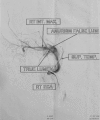Management of pseudoaneurysm of internal maxillary artery resulting from trauma
- PMID: 25838698
- PMCID: PMC4379221
- DOI: 10.1007/s12663-012-0427-x
Management of pseudoaneurysm of internal maxillary artery resulting from trauma
Abstract
Pseudoaneurysm of internal maxillary artery following trauma is a rare clinical entity. A rapidly growing swelling in the facial region following fracture of the mandibular subcondylar region is an indication of a developing aneurysm. A case of pseudoaneurysm of the internal maxillary artery following condylar fracture of mandible is reported. The case was treated successfully by surgery.
Keywords: Internal maxillary artery; Mandibular condylar fracture; Pseudoaneurysm.
Figures













References
-
- Rich NM, Spencer FC. Vascular trauma. Philadelphia: WB Saunders Co; 1978. pp. 233–259.
Publication types
LinkOut - more resources
Full Text Sources
